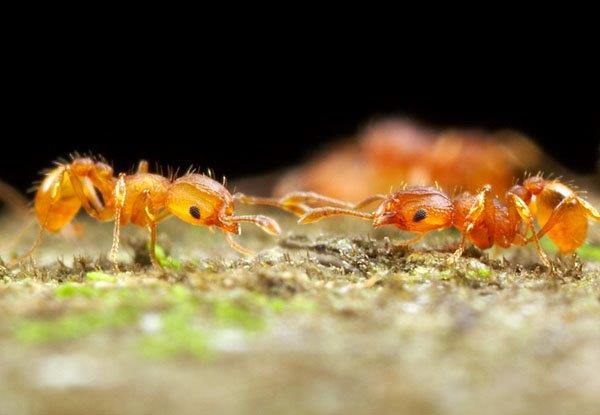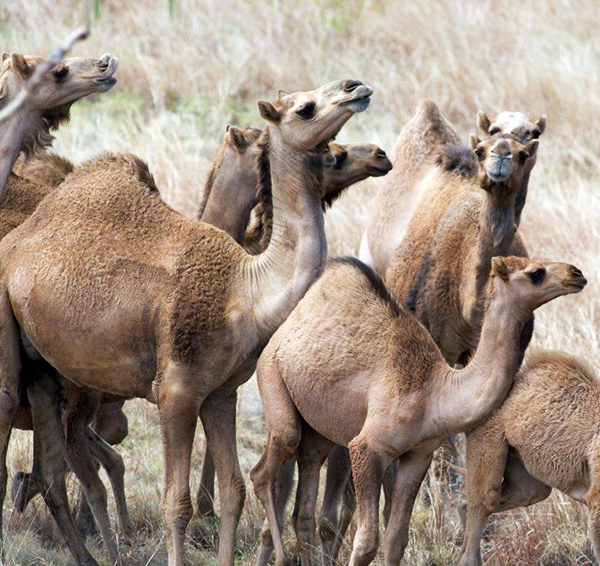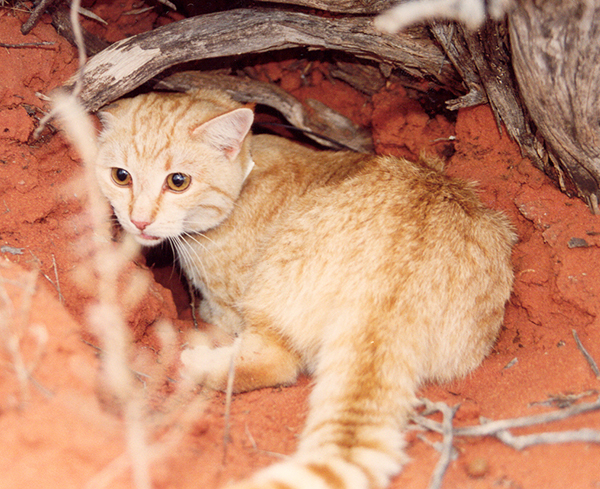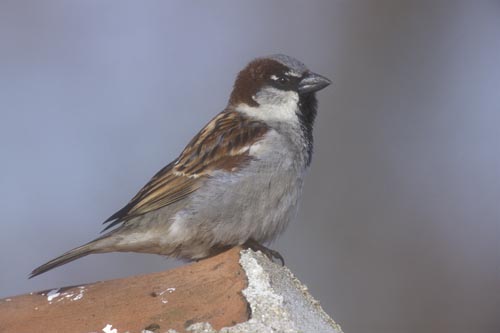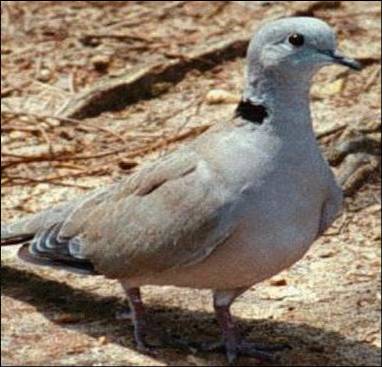Exotic invertebrates
About exotic invertebrates
Invertebrates are animals without a backbone.
Exotic invertebrates may have a large impact on the natural environment in the Northern Territory (NT) as they do all of the following:
- prey on native animals
- compete with native invertebrates for food and habitat
- can be aggressive towards other invertebrates and vertebrates
- can promote the spread and population growth of other pest invertebrates.
Exotic invertebrates may also bite or sting people, which can cause death in people with certain allergies. They can spread disease or be a pest in homes.
Bees, ants and wasps are of particular concern in the NT.
Exotic invertebrates in NT
These are the most damaging exotic invertebrate species in the NT.
European honey bee
European honey bees compete with native pollinators, such as bees and birds, for nectar and hollows in trees.
This has caused a decline in numbers of native animals in places where the honey bee is living.
European honey bees have also encouraged the spread of weeds, as they often choose the nectar of weeds over native plants.
These bees have a sting that can cause death in people with allergies.
Yellow crazy ant
Read more on the yellow crazy ant.
Big-headed ant
Read more on the big-headed ant.
Ginger ant
Read more on the ginger ant.
Pharaoh's ant
This ant competes with native ants for food and shelter.
It can also carry human pathogens. It can be dangerous if found in hospitals as it may increase infection rates.
Singapore ant
This ant competes with and preys on native invertebrates, which leads to a decrease in local ant diversity.
This species can cause economic damage in towns as it can gnaw through rubber and fabric. It has been known to remove rubber insulation from electric wiring and phone lines, and damage cables.
Ghost ant
This ant competes with native pollinators and robs the nectar from native plants. It has a nasty sting that can cause death in people with allergies.
Electric ant
These ants are found in Queensland and are not yet in the NT.
Red imported fire ant
These ants are not in the NT, but are a threat as they prefer tropical conditions.
European bumblebee
This species has not yet been recorded in the NT.
The European bumblebee can rob the nectar of native plants, disrupt native pollination, and spread weeds as it chooses the nectar of weeds over native plants.
This species has a nasty sting. The venom can cause severe reactions in some people, including swelling, nausea, vomiting and breathing problems.
Giant African land snail
This snail has been eradicated from the NT.
It has been linked to declines in invertebrates and plants, mainly due to competition for food and shelter.
Asian tiger mosquito
This mosquito is found in the Torres Strait, but has not been recorded in the NT.
This mosquito can spread disease and is suited to tropical climates.
Aedes aegypti mosquito
The dengue mosquito, Aedes aegypti, can spread disease and is currently only present in Queensland.
There is a continuous threat of this mosquito entering the NT.
Feral buffalo
Buffalo are a large herbivore weighing between 450kg and 1200kg. They are found in floodplain, woodland and sandstone escarpment areas where there is surface water.
Buffalo in the Northern Territory (NT) are generally found only in areas that receive greater than 1000mm of rainfall each year.
Water buffalo were imported into the NT in the 19th century as working animals and meat for the remote northern settlements. When the early settlements were abandoned, the buffalo were released, where they became feral.
Buffaloes have grown in numbers and are a pest in the Top End, particularly in the northern floodplains.
Impacts
Feral buffalo can cause huge environmental damage through their movement and feeding.
On floodplains, buffalo move along pathways called swim channels.
These channels destroy vegetation and erode the soil by creating new drainage channels. Swim channels have caused saltwater intrusion into freshwater plains, particularly in the Mary River area. This has led to the loss of large areas of paperbark forest.
Buffalo have also helped spread weeds, particularly Mimosa pigra on floodplains.
Feral buffalo have reduced the nesting activity of magpie geese, which has a major impact on the natural ecosystem and for recreational hunters.
Other evidence suggests that buffalo grazing may reduce the nesting activity of crocodiles, which has impacts on wild crocodile populations and commercial crocodile practices.
Management
Aerial shooting is the best way to control buffalo numbers. There is also some success with ground shooting. The NT Government works with Indigenous communities to help manage and monitor feral buffalo.
Currently some herds of buffalo are domesticated and there is pet meat shooting and live export of buffalo from some areas.
Generally, buffalo herds on pastoral lands are managed, but the largest population, found in Arnhem Land, is increasing in size and range and receives limited management.
For more information read the feral buffalo Arnhem Land distribution and abundance survey report PDF (921.7 KB).
Feral camel
Feral camels are found in over 37% of mainland Australia.
In the Northern Territory (NT), feral camels are found in over 40% of the land area.
Camels were first introduced into Australia from the Canary Islands in 1840. There are now over one million feral camels in Australia and that population may double in size every nine years.
Feral camels are found across Central Australia and in the Victoria River District regions.
Impacts
In Central Australia, feral camels feed on more than 80% of the available plants. In much of the NT there are more than two camels per square kilometre, which causes serious impact on native vegetation.
They are particularly destructive to the curly pod wattle, bean tree, quandong, plumbush and supplejack.
This damage has increased in drier years. Important food plants used by Aboriginal people are also seriously affected by camel grazing.
Feral camels have an impact on fragile salt lake ecosystems and foul waterholes, which are important sites for Aboriginal people and for native plants.
They also contribute to erosion by destabilising dune crests.
Camels damage stock fences, often over hundreds of metres, and infrastructure at cattle watering points.
Management
Management of feral camels is not consistent and has little impact on populations overall.
Management falls into three categories:
- fencing off key areas to keep out feral camels.
- live harvest of feral camels for commercial sale
- ground and aerial culling - in the NT aerial shooting is done by Parks and Wildlife contractors with the cost of helicopter hire and ammunition being paid by the land manager.
Although aerial shooting of large animals like horses and camels is an emotive issue, it is the most effective and humane way to cull large feral herbivores in remote areas that are hard to access.
Feral camels move over large areas so buffer zones are needed in arid regions to protect environmentally sensitive areas.
Feral cat
Feral cats have been in the Northern Territory (NT) for over 100 years and have adapted to all habitats, from rainforests to the desert.
Impact
Feral cats are a serious threat to conservation of biodiversity in the NT.
They can impact native animals in all of the following ways:
- direct predation
- competition for food and shelter
- disease.
Direct predation
Feral cats have played a role in the loss and extinction of native animals, particularly in Central Australia.
Overall 63 species of native vertebrate have been found in the stomachs of feral cats, including mammals, reptiles, birds and amphibians.
Competition
There is a lack of evidence on the effects of competition between feral cats and native species.
It is assumed that species similar to cats, such as the western and northern quolls, now have to compete for food, habitat, shelter and other resources.
Competition can also occur between cats and predatory birds.
Cats may reduce prey for raptors such as the brown goshawk and the peregrine falcon.
There is also a possibility of competition with larger reptiles such as elapid snakes and goannas that prey on a range of vertebrates similar to those taken by feral cats.
Disease
Cats can spread disease to native animals and humans.
Toxoplasmosis has been recorded in several dasyurids species - carnivorous marsupials such as quolls - although its impact on population numbers is unknown.
Management
It is difficult to control feral cats in the NT.
The only successful methods have been trapping or baiting. Bait can only be used when there is a lack of food as cats will not scavenge unless forced to.
Baits can also impact other species, including dingoes, which are protected in the NT.
Wild dog
The term wild dog includes the dingo and the feral domestic dog, as well as hybrids of these.
Dingoes are protected in the Northern Territory (NT).
You should not interfere with dingoes without a permit to take or interfere with wildlife.
Wild dogs are common throughout the NT, except for the Tanami Desert where they are rare due to the lack of water.
Packs of dingoes exist in this region where watering points have been introduced such as on pastoral properties, in mining areas and near towns.
Impact
There are a number of negative impacts caused by dingoes and wild dogs.
They can do all of the following:
- prey on livestock by causing economic loss to farmers
- prey on domestic livestock on rural blocks
- be a menace to tourists and staff at remote tourist resorts and national parks
- impact the survival of remnant populations of endangered animals.
Feral domestic dogs and hybrids are often more dangerous to humans and livestock than dingoes.
Wild dogs also spread disease such as hydatidosis in cattle and sheep, and heartworm and parvovirus in pet domestic dogs.
Hydatidosis, an infection caused by tapeworms, leads to offal being rejected from slaughtered abattoir cattle and may cause significant economic losses.
Management
Management is needed to control the numbers of wild dogs, while protecting purebred dingoes in the wild.
In the NT, wild dog control measures have been less intensive than in other states and territories, and there has been little or no change in the distribution of dingoes.
This is largely because livestock in the NT is restricted mainly to cattle, which are only preyed on by dingoes if there is a lack of other prey.
It is thought that over 90% of NT wild dogs are purebred dingoes, with hybrid and feral domestic dogs occurring mainly around urban areas.
Wild dog baiting with 1080 is a common control method for wild dogs.
Alternative methods to baiting include trapping, exclusion fencing and shooting.
Within towns wild dog control is the responsibility of the relevant town council or landholder.
Feral donkey
Donkeys were introduced to Australia from Africa in 1866 to work as pack animals.
Feral donkeys are common in the Katherine region of the Northern Territory (NT).
It is estimated there are tens of thousands of feral donkeys in the arid zones of Central Australia, Western Australia and the Top End.
They are able to tolerate various environmental conditions and produce a foal every year, so the population can increase quickly with good conditions.
Impact
Feral donkeys are a serious threat to the natural environment.
They can increase erosion of soil and waterways, spread weeds, trample native vegetation, eat native seedlings, cause sedimentation of water bodies, destroy infrastructure and compete with native species and domestic cattle for resources.
Management
Feral donkeys can be managed by doing any of the following:
- trapping or mustering to sell them commercially
- aerial culling - this is the most effective, environmentally friendly and humane way to remove large animals, though this needs to be done by someone with extensive training
- on-ground culling - this is humane and cheap, though it is limited to accessible areas
- fertility control - this is difficult to use on large numbers of feral donkeys and treatment needs to be repeated to be effective.
Feral horse
It is thought that there are 300,000 feral horses in Australia. They produce one to two foals each year, so their numbers increase quickly in the wild.
In the Northern Territory (NT), wild horses are found in large numbers to the west of Alice Springs, in the Gulf region, in the Victoria River District and to the south of Darwin as far as Katherine.
Impacts
Feral horses cause major damage to the natural environment.
This can include any of the following:
- erosion of soil and waterways
- spread of weeds
- trampling of native vegetation
- eating native seedlings
- sedimentation of water bodies
- destruction of infrastructure
- competition with native animals and domestic cattle for resources
- spread of disease and parasites to domestic stock and native animals.
Horses can travel 50km for food and water, which spreads their destructive impact.
Management
Feral horses can be managed in a number of ways.
This includes any of the following:
- trapping or mustering to sell them commercially
- aerial culling - this is the most effective, environmentally friendly and humane way to remove large animals, though this needs to be done by someone with extensive training
- on-ground culling - this is humane and cheap, though it is limited to accessible areas
- fertility control - this is difficult to use on large numbers of feral donkeys and treatment needs to be repeated to be effective.
Feral fox
In the Northern Territory (NT) foxes are found in the arid areas of Central Australia and the Barkly regions.
They appear to be moving towards the Top End and are now common as far north as Tennant Creek.
Impacts
The European red fox preys on many native animals and is a serious threat to biodiversity.
In the NT one of the last known wild populations of the rufous hare-wallaby was wiped out by one fox.
The bilby may also be at risk of extinction if foxes continue moving north into the bilby habitats.
Management
There are several ways to control fox numbers in the NT.
Poisoning
Foxes scavenge for food so baiting with 1080 is a successful way to control fox numbers.
Burying bait is also effective as foxes will dig up the baits. Burying is a good way to avoid killing other animals such as dingoes, which will not scavenge for bait.
Shooting
Shooting is not very effective in reducing fox numbers. Fox drives may remove a large number of foxes from a small area, but these are expensive and time consuming.
You shouldn't hunt foxes with dogs as it is inhumane.
Trapping
Trapping is hard work and time consuming. You must not use steel-jawed traps as they are inhumane and banned in most states and territories, including the NT.
Soft-catch traps with padded rubber jaws and leg snares are are less damaging and humane options.
Den fumigation
This is a good local control method when cubs are born, but it is difficult as dens are hard to find.
Fencing
Fencing can keep foxes out of areas that are important to agriculture or conservation. Foxes can be good at scaling fences even when they are electrified.
Other farming practices
Some farming methods can reduce the impacts of foxes on properties. This may include changing the time of lambing and the location of lambing paddocks so that the chance of fox attacks is reduced.
Controlling rabbit numbers can reduce the number of foxes in the area.
Feral pig
Alert
African swine fever has been confirmed in countries close to Australia including Timor Leste.
Early reporting is critical for containing the disease. Report any sick or dead pigs by calling 1800 675 888.
Find out more about African swine fever.
It is believed that there are between 13 million and 23 million feral pigs spread across Victoria, New South Wales, Queensland and Northern Australia.
Feral pigs need water daily, so they are usually found close to water.
They reproduce quickly as young pigs reach sexual maturity at around seven to 12 months. They can produce one or two litters each year.
Read more on feral pigs and their impact on agriculture in the Northern Territory PDF (84.0 KB).
Impacts
Feral pigs are one of Australia's most serious feral pests.
The key threats from feral pigs are predation, habitat destruction, competition and disease.
Pigs root for food - uprooting the ground for plant material - which is very destructive to the environment.
Rooting may cause any or all of the following impacts:
- disrupt the seed bank
- disturb vegetation
- change the soil composition
- spread weeds
- spread the seeds of exotic plants
- increase erosion and soil sedimentation
- destroy the habitat of native species.
Pigs compete with native species for food as they eat a variety of plants, small animals and invertebrates.
Pigs will trample and hunt for eggs, which has impacted some native turtles and is assumed to affect the eggs and young of some birds.
Feral pigs can cause damage to farms by destroying crops, damaging irrigation systems and infrastructure and reducing seedling recruitment.
They are responsible for large losses of sugarcane and have been known to kill and eat a large number of newborn lambs.
They can also spread diseases including brucellosis, psuedorabies, leptospirosis, foot-and-mouth disease and Japanese encephalitis, and the fungus Phytophthora cinnamomi.
Management
There are a number of ways to control feral pigs including any of the following:
- baited trapping - this is most successful for small numbers if traps are placed around waterholes
- mustering
- aerial culling
- poison with 1080 - this can be effective for small numbers, though it is hard work, time consuming and there is a risk of poisoning protected animals
- fencing.
Feral rabbit
Rabbits are Australia's worst pest.
In the Northern Territory (NT) they are found mainly in the arid Central Australian region.
Impacts
The main threats of rabbits are competition and land degradation.
In Central Australia, they have caused economic losses to farmers and huge environmental damage by changing the landscape and competing with native animals for food and shelter.
Rabbits compete with livestock for food by overgrazing and reducing trees and shrubs by killing mature plants and preventing seedling growth.
They damage soils, causing erosion problems and destroy native plants.
In the NT rabbits are linked to the decline in bilby numbers and the disappearance of the burrowing bettong.
Management
Biological control has been important to rabbit population control. This has included introducing several diseases that only affect rabbits, including myxomatosis, the European rabbit flea, the Spanish rabbit flea and the rabbit haemorrhagic disease.
Rabbit haemorrhagic disease proved very successful in the NT and has reduced rabbit numbers by more than 80%.
Other control methods used include all of the following:
- ripping warrens with a bulldozer with ripping tines
- exclusion fencing
- trapping
- poisoning
- shooting
- fumigation.
Black rat
The black rat is found throughout Australia, most often seen in urban environments.
They prefer to live in roofs, cavity walls, trees, scrapes or burrows around farms.
The black rat is found in many locations across the Northern Territory (NT), from the Top End through the Victoria River District, Barkly and Gulf regions to Central Australia.
It has spread across Australia as it has a diverse diet and breeds well.
Impacts
Black rats prey on bird eggs and may be responsible for the decline in numbers of many birds.
They also prey on birds, invertebrates and lizards, as well as consuming seeds that would otherwise be eaten by native animals.
Management
If you have a problem with black rats, you can try any of the following control methods:
- remove access to all food
- dispose garbage away from your house
- remove animal or pet food that rats can access
- rat-proof any food storage areas or containers
- if you have a farm with rodent problems, encourage birds of prey and snakes to live and breed on your property.
Feral cattle
Feral cattle cause all of the following damage to the environment:
- land degradation by trampling
- soil compaction and erosion
- increased nutrient loading
- spreading of weeds
- sedimentation of waterways.
Feral cattle can affect agricultural productivity by competing with domestic cattle for food and water.
Feral cattle can carry and spread disease and may cause problems during disease control operations.
Some farmers use feral cattle for domestic and international markets, so putting control programs in place can be difficult. It is important to control feral cattle as they cause trouble in mustering, handling and population control of domestic cattle.
Brown rat
The brown rat is common in urban areas of the Northern Territory (NT).
Impact
Brown rats don't make a large impact on the natural environment as they are found in urban areas.
They do affect the biodiversity of the area by eating small birds, lizards, small native mammals, rodents and amphibians.
Brown rats will eat almost anything and compete with native species for resources.
Management
If you have a problem with brown rats, you can try any of the following control methods:
- remove access to food
- dispose garbage away from your house
- remove any animal or pet foods that rats may access
- rat-proof any food storage areas or containers.
Banteng
The banteng look like domestic cattle, but are smaller and have white patches on their rump and lower legs.
The Northern Territory (NT) has the largest population of banteng in the world on the Coburg Peninsula.
Despite being a feral animal in the NT, they are listed as vulnerable to extinction in their native South East Asia.
Banteng have a huge impact on the NT environment.
Their grazing affects the vegetation and their trampling damages sand dune ecosystems and wetlands.
Gambusia
The gambusia is commonly known as the mosquito fish as it was introduced from America to control mosquito numbers in Australia in the 1920s.
Gambusia made a minimal impact on mosquito populations and are now a major pest in Australia. Each year a female may produce over 300 young, so their population has grown very quickly.
This population has a high survival rate because of their tolerance to many environmental conditions.
Impact
Gambusia are hardy fish and have a high tolerance of temperature, salinity, turbidity and dissolved oxygen in the water.
They are aggressive and will prey on native fish, amphibian eggs and water bugs. They aggressively compete with native species for food and habitat - they will even nip at the fins of smaller fish species, which can cause infection and death.
Gambusia have lead to the decline in nine native fish and over 10 frog species in Australia. Worldwide, gambusia have been linked to the decline of around 30 fish species.
Management
Gambusia are a noxious fish in the NT and the possession of gambusia is banned.
You should not keep gambusia or ever release them into the wild.
If you have spotted a gambusia, take a photo if you can and report it to Fishwatch or aquatic biosecurity.
Fishwatch Hotline
1800 891 136
Aquatic Biosecurity
Feral goat
Feral goats are found across Australia, except on the mainland of the Northern Territory (NT).
In the 1980s and early 1990s groups of wild goats were removed from north and north-east of Alice Springs.
Feral goats are still found on some offshore islands including North East, North Goulburn, Truant and Vanderlin.
Impact
Feral goats are a major environmental and agricultural pest.
They are hardy animals and can increase their numbers by over 50% each year.
They compete with domestic stock for food and cause land degradation through soil damage, overgrazing and strip-browsing.
Trampling by feral goats breaks up the soil's crust and protective cover of vegetation.
If feral goat numbers are not managed, they can cause large losses of biodiversity. Woody and non-woody native plants have difficulty maintaining population numbers with goats.
Island habitats are particularly vulnerable to feral goats.
Management
Mustering and trapping are used to catch goats for the meat trade.
Management of small herds or those in dense and rough landscape need aerial or ground shooting. The use of judas goats - goats equipped with radio tracking collars - can make these techniques more effective.
Dingoes are a good biocontrol option as goats are easy prey for dingoes and do not usually survive in dingo territories.
House mouse
The house mouse is widespread in the Northern Territory (NT) and across Australia.
Impact
House mice are not a great threat to biodiversity. As house mice eat seeds and cereal grains, there is some concern of their impact on native vegetation.
In some areas, house mice also prey on young birds.
In urban areas, house mice are a nuisance as they will do any of the following:
- spoil food and food packaging
- carry and spread disease
- damage buildings
- threaten farming by eating grain, fruits and vegetables.
Management
If you have a problem with house mice, you can try any of the following options:
- remove access to food
- dispose garbage away from your home
- remove animal or pet food that mice can access
- mouse-proof food storage areas or containers.
House sparrow
House sparrows are found mainly in urban areas in the eastern half of the Northern Territory (NT).
They can also be found around remote homesteads where they survive on grains and seeds.
Impact
House sparrows in urban areas have little impact on biodiversity.
They are highly aggressive towards other birds and will take over the nest sites of native species.
House sparrows will also break the eggs of other birds, leading to a decline in native bird numbers.
In agricultural areas, house sparrows will eat large amounts of grain and seed, which affects the productivity of the farm.
Management
If you have a problem with house sparrows in or around your house, you can try the following options:
- block any holes or gaps around the house where they can build a nest
- remove active nests and eggs
- remove scraps of food near the house.
Feral pigeon
Feral pigeons are found in all major cities in Australia, except Darwin.
They thrive living around people as they use buildings for nest sites and eat scraps and unwanted food around towns and cities.
Impact
Feral pigeons have a small impact on biodiversity.
They compete with native birds for food and are a public nuisance due to all of the following reasons:
- they will nest in buildings where they make noise
- they flock in areas where food is available, causing a lot of mess
- they may spread disease and parasites
- occasionally they become an agricultural nuisance.
Management
If you have a problem with pigeons you can try any of the following options:
- avoid feeding your pets outside, as this attracts pigeons into your yard
- always cover chicken pens to keep pigeons out.
Rusa deer
In the Northern Territory (NT) rusa deer are found on Groote Eylandt and smaller islands in the Gulf of Carpentaria.
Impact
Introduced deer can degrade native vegetation by overgrazing, browsing, trampling, ring-barking and spreading weeds.
They can be responsible for eroding waterways and decreasing water quality.
Sambar deer
Sambar deer are found on the Coburg Peninsula and in Western Arnhem Land in the Northern Territory (NT).
Impact
Introduced deer can degrade native vegetation by overgrazing, browsing, trampling, ring-barking and spreading weeds.
They can be responsible for eroding waterways and decreasing water quality.
Spotted turtle-dove
In the Northern Territory (NT), the spotted turtle-dove is found in Alice Springs. It is common in eastern and southern Australia, particular in major towns and cities.
Spotted turtle-doves are common in urban areas, where you can see them in parks, gardens and agricultural areas. They eat grains and seeds, but in cities they will also eat scraps and commercial foods.
Impact
Spotted turtle-doves compete with native species for food and habitat.
Spotted turtle-doves may also carry parasites and disease, which can threaten native birds.
Management
If you have a problem with spotted turtle-doves around your house you can try the following options:
- avoid feeding your pets outside, as this attracts spotted turtle-doves
- always cover chicken pens to keep spotted turtle-doves out.
Barbary dove
The Barbary dove has been recorded in Alice Springs, Tennant Creek and Darwin.
It is illegal to keep Barbary doves in the NT without a permit.
Impact
Barbary doves may compete with native species for food and habitat. They may also carry parasites and diseases which can threaten native birds.
Barbary doves are often a nuisance to people because of their nesting behaviour and droppings around the house.
Management
If you see a Barbary dove in the wild, you should report it to the Department of Environment, Parks and Water Security.
Storybooks and resources about feral animals
This page has educational material for children and adults to teach you about feral animals in the Northern Territory (NT).
You can download all of the following resources to learn about feral animals in the NT:
- Ferals in the Northern Territory (A3 poster) PDF (3.1 MB)
- Feral animals: Not Local to Country (Indigenous storybook) PDF (8.0 MB)
- Removing Karnbulanyi from the Islands of the North (Indigenous storybook) PDF (2.6 MB)
- Feral buffalo storybook PDF (9.3 MB)
- Feral dog PDF (7.1 MB)
- Feral horse and donkey storybook PDF (5.4 MB)
- Feral cat storybook PDF (7.1 MB)
- Feral pig storybook PDF (12.2 MB)

